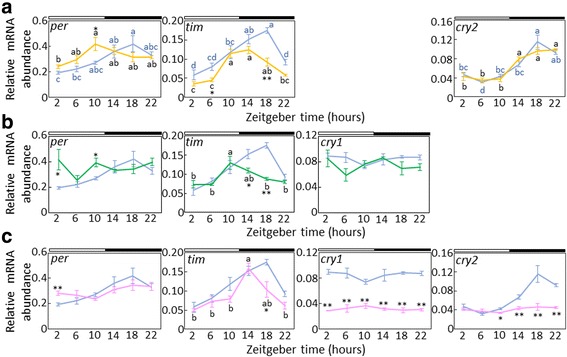Fig. 5.

Effects of Gb’cry1 RNAi (a), Gb’cry2 RNAi (b), and Gb’cry1 RNAi/Gb’cry2 RNAi (c) on daily clock gene expression. Relative abundance of Gb’per, Gb’tim, Gb’cry1, and Gb’cry2 mRNA in the optic lobes are shown for intact (blue) and Gb’cry1 RNAi (yellow) (a), Gb’cry2 RNAi (green) (b), and Gb’cry1 RNAi/Gb’cry2 RNAi (pink) adult male crickets (Gryllus bimaculatus) (c). The data for intact Gb’cry1 and Gb’cry2 mRNA are replotted from Fig. 2. In dsRNA-injected crickets, the optic lobes were collected about seven days after the dsRNA injection. The abundance of mRNA was measured by quantitative real-time RT-PCR with total RNA extracted from the optic lobes. The data collected from 3 and 5 independent experiments were averaged and plotted as mean ± SEM for dsRNA-injected and intact crickets, respectively. The abundance of Gb’rpl18a mRNA was used as an internal reference. Asterisks indicate significant difference between intact and treated crickets (*P < 0.05, **P < 0.01, t-test). Different letters indicate that values are significantly different with each other (ANOVA followed by Tukey-test, P < 0.05). For further explanations, see the text
